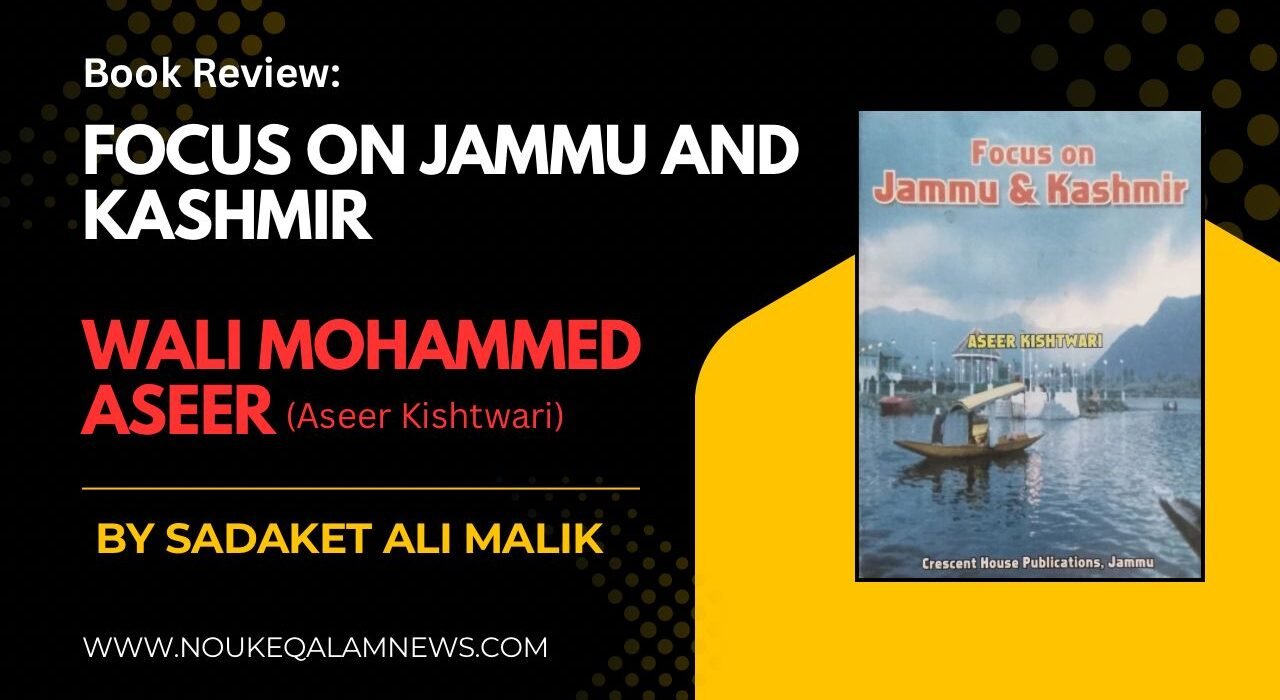The Chenab Valley, comprising the trio of districts—Kishtwar, Doda, and Ramban—was once scarce in literary representation. However, over the past few decades, that has changed significantly, and today, the Chenab region stands as a vital representation of Jammu and Kashmir on the national map.
Focus on Jammu and Kashmir by Wali Mohammed Aseer (Aseer Kishtwari), a Sahitya Akademi Awardee, is a monumental work published by Crescent Publications, Jammu. Spanning 1,264 pages, the book offers an encyclopedic exploration of the region. With a foreword by renowned historian Dr. Fida Mohammad Husnain, it stands out as a unique blend of history, culture, politics, geography, and literature, focused on the complex and diverse landscape of Jammu and Kashmir. Divided into two parts, it serves as both a historical archive and a socio-cultural commentary, offering insights not only into past events but also into the spirit and essence of the people and places of Jammu and Kashmir.
The opening chapter lays a solid foundation with exhaustive detail on the region’s geography, population, flora and fauna, climate, irrigation, agriculture, mineral wealth, communication systems, administrative setup, and cultural fabric. Aseer vividly captures the region’s diverse landscape—from majestic peaks and serene meadows to sacred springs and lush orchards. The chapter also includes historical infrastructure like the evolution of the Civil Secretariat, adding administrative depth to the narrative.
The history of Jammu is explored through the lens of ancient dynasties—Bodh Arjan, Rai, Dhar, Dev, and others—each contributing to the region’s evolution. The second chapter traces the rise of local politics, power shifts, and alliances, culminating in the emergence of Gulab Singh and the Treaty of Amritsar. Aseer carefully examines regional governance complexities and imperial politics, contextualizing Jammu’s historical significance within broader South Asian dynamics.
The third chapter delves into the smaller princely states—Reasi, Samba, Bhaderwah, Rajouri, Poonch, and others—emphasizing their unique governance and cultural identities. Aseer’s meticulous research sheds light on these often-overlooked micro-histories, enhancing our understanding of Jammu’s regional diversity.
Ladakh’s history is presented with references to Buddhist and Dogra influences, detailing early dynasties and conquests. The chapter, though brief, highlights Ladakh’s strategic location and rich culture, reflecting its distinct identity as both culturally Tibetan and politically integral to the state.
Kashmir’s famed beauty is matched by its intricate history—from the Lohar dynasty to Shahmiri, Chak, Mughal, Afghan, and Sikh rules. Aseer introduces significant yet underrepresented figures such as Rentchan Shah and Kota Rani. His focus on dynastic transitions and key treaties sets the stage for understanding Kashmir’s later political developments.
Aseer also explores the Dogra rule under Maharajas Gulab Singh, Ranbir Singh, Pratap Singh, and Hari Singh, documenting their governance, reforms, and challenges. The freedom struggle, the formation of the Muslim Conference, the Quit Kashmir movement, and the rise of the National Conference are discussed in detail. The signing of the Instrument of Accession and its implications are examined with nuance and care, forming a critical bridge between pre- and post-independence politics.
Further, the book covers India’s complaint to the United Nations, speeches by key leaders such as Sheikh Abdullah, and various UN resolutions. Aseer presents multiple political perspectives, offering a legal, diplomatic, and humanistic view of the conflict.
Post-accession Kashmir under leaders such as Sheikh Abdullah and Bakhshi Ghulam Mohammad is thoroughly analyzed. The formation of the Interim Government, Article 370, the Delhi Agreement of 1952, and constitutional developments are all critically examined. Aseer does not shy away from controversial episodes such as the wars of 1965 and 1971, the Hazratbal incidents, hijackings, and the rise of militancy. His writing balances objectivity with emotional depth, reflecting the region’s turbulent trajectory.
The book chronologically recounts major events during the insurgency—communal violence, political assassinations, peace talks, elections, and military operations. Incidents such as the exodus of Kashmiri Pandits, massacres, attacks on Parliament, the Hurriyat Conference, and Mufti Sayeed’s tenure are presented with balance and detail. Aseer’s sober tone and commitment to accuracy help preserve the historical record while honoring those affected.
One of the book’s most vibrant sections explores the region’s art, museums, architecture, dance, festivals, cuisine, and linguistic diversity. Aseer’s love for the culture of Jammu, Kashmir, and Ladakh is evident. His inclusion of folk traditions, regional art forms like Pahari painting, and in-depth discussion on local languages is a significant contribution to cultural scholarship.
Turning to his native region, Aseer provides an intimate portrayal of the erstwhile Doda district—its terrain, people, dialects, and socio-economic conditions. The documentation of biodiversity, customs, and infrastructure offers a localized case study. His detailed genealogical accounts—from Raja Nagpal to Maharaja Hari Singh—reveal deep-rooted knowledge, enhanced by oral traditions and historical texts.
The book also explores the religious diversity of Jammu and Kashmir through its sacred sites and saints. Aseer highlights spiritual figures across Islamic, Hindu, Sikh, and Buddhist traditions, emphasizing the region’s syncretic spirit. He covers both well-known sites such as Sarthal Devi and Dastgir Sahib and lesser-known village shrines, offering a spiritual cartography of the state.
Another valuable section focuses on the linguistic and literary life of Doda and beyond. Aseer catalogues languages such as Bhaderwahi, Bhalesi, Kishtwari, Sirazi, Pogli, and Gojri, and highlights literary figures and organizations preserving these tongues. This rare documentation is vital to the linguistic preservation of the Chenab Valley.
The final chapter offers biographical notes, reviews, and tributes to Aseer by fellow writers, historians, and journalists. It frames his life’s work as both a chronicler and a cultural custodian. Far from self-aggrandizement, it validates his lifelong dedication to literature and historiography.
The book concludes with sixteen appendices, including foundational documents like the “Naya Kashmir” manifesto, UN resolutions, ceasefire agreements, and the Dixon Report—valuable primary sources that enhance the book’s scholarly merit.
In short, Focus on Jammu and Kashmir is not merely a book—it is a repository of history, culture, struggle, and identity. Wali Mohammed Aseer combines the historian’s rigor with the poet’s soul, presenting an expansive view of Jammu and Kashmir while staying deeply rooted in the local. The book’s strength lies in its detail, multiplicity of perspectives, and fearless engagement with politically sensitive issues.
Though its length and depth may challenge some readers, for scholars, researchers, and admirers of the region, this work is indispensable. It bridges the macro and micro, political and cultural, personal and historical. Aseer’s contribution deserves to be recognized as a landmark in South Asian regional studies.
Sadaket Malik is a Researcher and Empaneled Translator under NTM, CIIL Mysore.
http://sadaketmalik.blogspot.com





